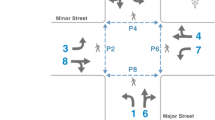Abstract
With the advances in the computational technology, microscopic traffic simulation models have become more realistic than ever, for example, 3D animations. They have been widely adopted as decision-supporting tools on various traffic operation and management studies. However, very few studies analyzed pros and cons of these models. At times, a microscopic simulation program is selected only because it was available for the engineers at the time of study. In practice, model selection has not been well exercised mainly due to the lack of available literature and experience. This paper presents a quick overview of four microscopic traffic simulation models and evaluates their performances using a case study of modeling a coordinated signal system. Models studied in this paper are CORSIM, Paramics, SIMTRAFFIC, and VISSIM. In order to provide reference performance measures for various traffic signal settings including pretimed and actuated controls, SYNCHRO program is utilized.
Similar content being viewed by others
References
ATMS R&D and System Engineering Program Team (2001).TSIS User's Guide Version 5.0, ITT Industries, Inc., March 2001.
Garber, Nicholas J. and Lester A. Hoel (1996).Traffic and Highway Engineering-Revised Second Edition, PWS Publishing.
Husch, D. and Albeck, J. (2000).SIMTRAFFIC 5.0 User Guide for Windows, Trafficware Corporation, Albany, CA.
Husch, D. and Albeck, J. (2000).SYNCHRO 5.0 User Guide for Windows, Traffieware Corporation, Albany, CA.
Lee, D.H. and Yang, X. (2000). “Parameter Optimization for Paramics using a Genetic Algorithm.”Proceedings of the ASCE 6th International Conference on Application of Advanced Technologies in Transportation Engineering, Singapore.
Lee, S.S. and Carroll J. Messer (2002). “Assessment of Three Traffic Simulation Models for Diamond Interchange Analysis.”Paper presented at TRB 2002 Annual Meeting, Washington D.C., January 2002.
Ma, Tao and Baher Abdulhai (2002). “GENOSIM: A Genetic Algorithm-Based Optimization Approach and Genetic Tool for the Calibration of Traffic Microscopic Simulation Parameters.”Paper presented at TRB 2002 Annual Meeting, Washington D.C., January 2002.
QUADSTONE Ltd. (2001).Modeller V3.0 User Guide, Edinburgh, UK.
Rilett, L.R. and Kim, K.O. (2001). “Comparison of TRANSIM and CORSIM Traffic Signal Simulation Modules.”Journal of The Transportation Research Board, TRR 1748, TRB, National Research Council, Washington D.C.
Wiedemann, R. (1974).Simulation des Strabenverkehrsflusses, Schriftenreihe des Instituts fur Verkehrswesen der Universitat karsruhe, Heft 8.
Wiedemann, R. (1991). “Modelling of RTI-Elements on multi-lane roads.”In: Advanced Telematics in Road Transport edited by the Comission of the European Community, DG XIII, Brussels.
White, Timothy (2001). “General overview of Simulation Models.”49th Annual Meeting, Southern District Institute of Transportation Engineers, Williamsburg, Virginia.
Author information
Authors and Affiliations
Rights and permissions
About this article
Cite this article
Park, B., Yun, I. & Choi, K. Evaluation of microscopic simulation tools for coordinated signal system deployment. KSCE J Civ Eng 8, 239–248 (2004). https://doi.org/10.1007/BF02829124
Received:
Accepted:
Issue Date:
DOI: https://doi.org/10.1007/BF02829124




